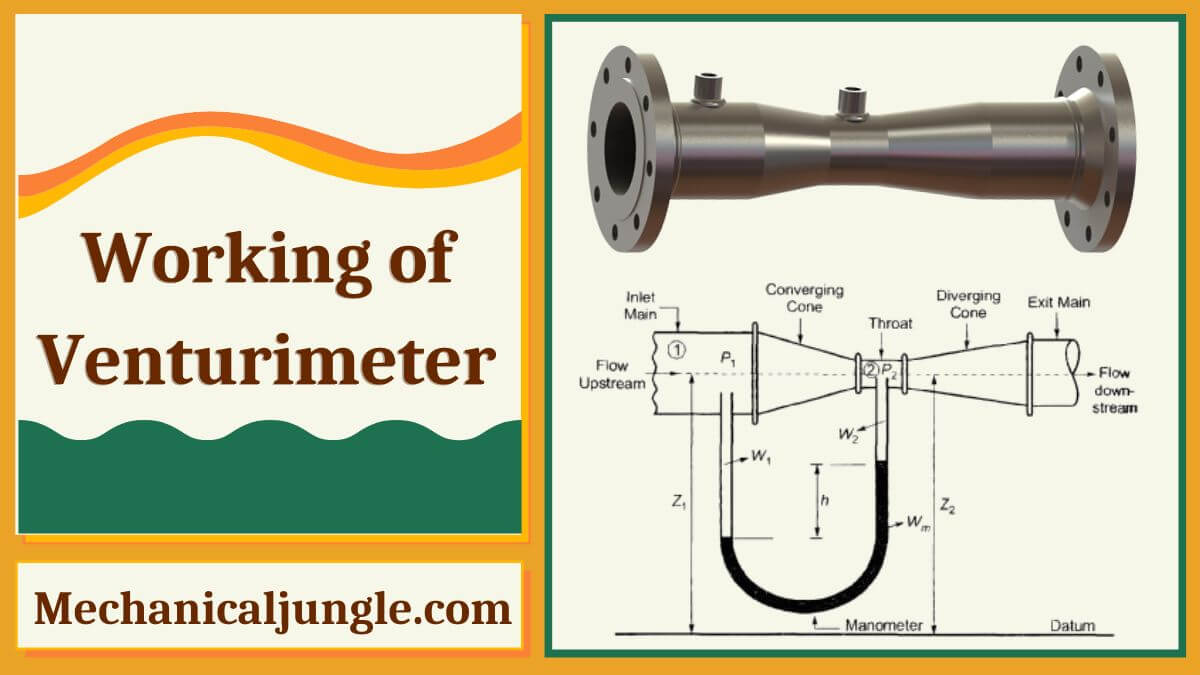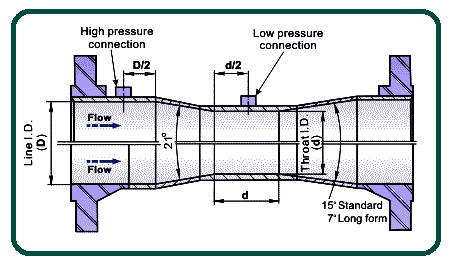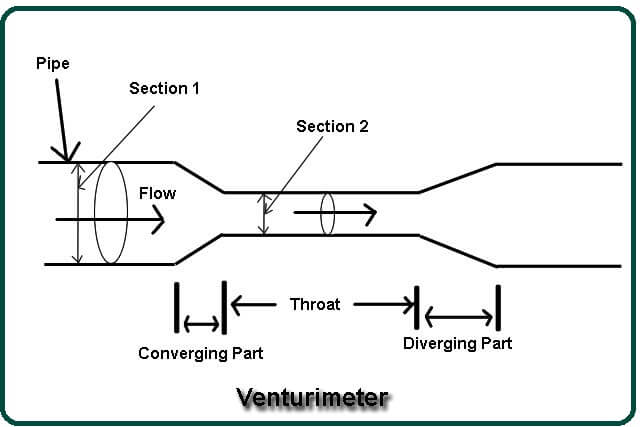
What Is a Venturimeter?

Venturi meters are used to measures the flow rate of a fluid through a pipe. This is an application of Bernoulli’s equation. Venturi meter theory works on the Bernoulli equation such that the velocity increases as the pressure decreases.
Venturi meter theory G.B. Venturi in 1797, but it was first introduced in 1887 c, considered with Herschel’s help.
This theory states that when the cross-sectional area of the flow decreases, a pressure difference between the different regions of the flow is created, and it helps to measure the difference under pressure. This pressure differential helps to measure the discharge inflow.
Working of Venturimeter:
- The venturimeter works on the principle of Bernoulli’s equation, i.e., the pressure decreases as the velocity increases.
- The cross-section of the throat is less than the cross-section of the inlet pipe.
- As the cross-section from the inlet pipe to the throat decreases, the velocity of the fluid increases, and hence the pressure decreases.
- Due to the decrease in pressure, a pressure difference is created between the inlet pipe and the venturimet’s throat.
- This pressure difference can be measured by applying a differential manometer between the inlet section and throat section or using two gauges on the inlet section and throat.
- The pressure difference through the pipe is calculated after obtaining the flow rate.
Construction of Venturimeter:

- As stated above, it consists of three parts, the part of the larynx and the deviation. These three parts are arranged in a systematic order. The first is an inlet section or converging section.
- This is the area where the cross-section emerges in a conical shape for contact with the throat region. In this section, the cross-section area decreases from beginning to end.
- This section is connected by an inlet pipe at one end and a cylindrical throat at the other end. The angle of convergence is typically 20–22 °. the other is a cylindrical larynx.
- This is the central part of the venturimeter. It is a cylindrical pipe in the ventimeter through which the fluid passes after converting to the convergence section.
- The throat usually has a diameter of the throat that is half the diameter of the pipe. The throat diameter remains the same through its length. The last one is turning the section.
- This is the end of the ventimeter. On one side, it is connected to the throat of the venturimeter, and on the other side is attached to the pipe.
- The divergent section has an angle of 5 to 15 degrees. The deviation angle is less than the convergence angle because the length of the deviation cone is larger than the convergence cone. The main reason for the small deviation angle is to avoid isolation of the flow from the walls.
The Expression for the Rate of Flow-Through Venturimeter:

Consider a venturimeter is fitted in a horizontals pipe through which fluid ( water ) is flowing, as shown in the figure below.
Let,
a1 = cross-section area of the inlet pipe
d1 = diameter of the inlet pipe
v1 = velocity at the inlet pipe
p1 = pressure at the inlet pipe
also,
a2 = cross-section area of the throat
d2 = diameter of the throat
v2 = velocity at the throat
p2 = pressure at inlet throat
d1, p1, v1, and a1 are the diameters at the inlet, the pressure at the inlet, the velocity at the inlet, and the area at cross-section 1.
And d2, p2, v2, and a2 are the corresponding values in section 2.
Applying Bernoulli’s equations in sections 1 and 2

As the pipe is Horizontals, so z1 = z2

Therefore (P1 – P2)/ρg is the difference of pressure heads at sections 1 and 2, and it is equal to h. so

Substituting these values of h in equation (1), we get

Now applying continuity equations at section 1 and 2

Substituting this value of v1 in equations (2) and solving, we get

Discharge
![]()
Substitutions the value of v2 in the above equation

Q is the theoretical discharges under ideal conditions. The actual discharge will be less than the theoretical discharge. The actual discharges are given by the formula.

Where Cd is the coefficients of the venturimeter, and its value is less than 1.
Disadvantages of Venturimeter:
- The installation cost of a venturi meter is high.
- There are some difficulties during maintenance.
- This device cannot be used where the pipe has a small diameter of 76.2 mm. Non-linear.
- This system occupies more space than the orifice meter.
- This is the lower Reynolds number limit of 150,000.
- It is expensive and a bit heavy.
So, this is all about the venturimeter. I hope you will understand the concept of venturi meter and also be able to understand how it works. If you liked this stuff, then don’t forget to share this article on your favorite social media platforms.
Advantages of Venturimeter:
The advantages of a Venturimeter are as follows.
- The power loss is very less.
- It can be used where a small head is available.
- High reproducibility (to the extent of consistently achieving results when an experiment is repeated).
- Accuracy is greater in wide flow ranges.
- It can also be used for compressed and incompatible fluid.
- This device is easy to operate.
- The coefficient of discharge (CD) is higher for the venturi meter.
- It is widely used for high flow rate (discharge).
Applications of Venturimeter:
Applications of Venturimeter are as follows.
- Calculating the flow rate of liquids that are discharged through pipes.
- In the industrial sector, it is used to determine the pressure of the volume of gas and liquid inside a pipe.
- The flow of chemicals in pipelines.
- It is widely used in the waste treatment process, where larger diameter pipes are used.
- It is also used in the medical field to measure the rate of blood flow in the arteries.
- It is also used where high-pressure recovery is required.
FAQs About Venturimeters
What is a Venturimeter?
A Venturimeter is a device used to measure the flow rate of fluids in pipes based on the principle of Bernoulli’s equation. It consists of three main sections: the inlet, throat, and diverging section.
How does a Venturimeter work?
A Venturimeter works by creating a constriction in the flow path, which accelerates the fluid and causes a pressure drop. This pressure difference is measured to determine the flow rate.
What are the advantages of using a Venturimeter?
- Minimal power loss
- Suitable for locations with limited headroom
- High reproducibility and accuracy across various flow rates
- Can handle a wide range of fluids, including gases and liquids
What are the disadvantages of using a Venturimeter?
- High initial installation cost
- Maintenance can be challenging
- Not suitable for small diameter pipes (< 76.2 mm)
- Limited application at low Reynolds numbers (< 150,000)
Where are Venturimeters commonly used?
- Measuring liquid flow rates in industrial pipelines
- Monitoring fluid pressures in chemical processing
- Assessing flow rates in wastewater treatment plants
- Measuring blood flow rates in medical applications
How accurate is a Venturimeter?
Venturimeters are known for their high accuracy, especially within a wide range of flow rates. The coefficient of discharge (Cd) is relatively high compared to other flow measurement devices.
What is the typical construction of a Venturimeter?
It consists of a converging section (inlet), a throat where the constriction occurs, and a diverging section. The angles of convergence and divergence are designed to optimize fluid flow and pressure measurements.
Can a Venturimeter be used with both gases and liquids?
Yes, Venturimeters are versatile and can accurately measure the flow rates of both gases and liquids, making them suitable for a wide range of industrial and scientific applications.
How do you calculate flow rate using a Venturimeter?
Flow rate (Q) through a Venturimeter is calculated using the formula Q = Cd * A1 * v1, where Cd is the discharge coefficient, A1 is the cross-sectional area of the inlet pipe, and v1 is the velocity of the fluid at the inlet.
What are some considerations for choosing a Venturimeter?
When selecting a Venturimeter, factors such as the required flow rate range, fluid type (gas or liquid), installation space, and budget for initial setup and maintenance should be taken into account.

